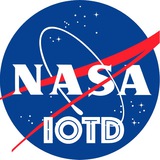If you have ever seen a series of concentric rings of color near a mist or fog, you have likely seen a glory. This colorful optical phenomenon, bright red on the outside and blue toward the center, forms when water droplets scatter sunlight back toward a source of light. http://www.nasa.gov/sites/default/files/thumbnails/image/guadalupe_amo_2018154_lrg.jpg
The Earth's limb and the Pacific Ocean contrast segments of the International Space Station's Kibo laboratory module built by the Japan Aerospace Exploration Agency in this June 23, 2018 image. At right is a portion of the Experiment Logistics Module, Pressurized Section (ELM-PS) which is the Kibo lab's storage facility. http://www.nasa.gov/sites/default/files/thumbnails/image/43026247071_324656e26b_o.jpg
NASA’s Ikhana aircraft, based at the agency’s Armstrong Flight Research Center in Edwards, California, takes off on June 12, 2018, for the agency’s first large-scale, remotely-piloted aircraft flight in the national airspace without a safety chase aircraft. http://www.nasa.gov/sites/default/files/thumbnails/image/afrc2018-0127-12.jpg
At 5:42 a.m. EDT Friday, June 29, 2018, SpaceX's Dragon spacecraft lifts off on a Falcon 9 rocket from Space Launch Complex 40 at Cape Canaveral Air Force Station in Florida. Dragon is carrying more than 5,900 pounds of research, equipment, cargo and supplies that will support dozens of investigations aboard the International Space Station. http://www.nasa.gov/sites/default/files/thumbnails/image/42374725534_a653d1b7cb_k.jpg
Citizen scientist Kevin M. Gill created this image of Jupiter using data from the Juno spacecraft's JunoCam imager. http://www.nasa.gov/sites/default/files/thumbnails/image/pia22425.jpg
Like a July 4 fireworks display a young, glittering collection of stars looks like an aerial burst. http://www.nasa.gov/sites/default/files/thumbnails/image/stsci-gallery-1022a-2000x960.jpg
Light from the County Fire illuminated the night skies of Northern California when the Suomi NPP satellite acquired this image overnight on July 1, 2018. http://www.nasa.gov/sites/default/files/thumbnails/image/california_vir_2018182_lrg.jpg
One of the most actively changing areas on Mars are the steep edges of the North Polar layered deposits. http://www.nasa.gov/sites/default/files/thumbnails/image/pia22535.jpg
Posted to Twitter by @Astro_Alex, European Space Agency astronaut Alexander Gerst, this image shows our planet's Moon as seen from the International Space Station. http://www.nasa.gov/sites/default/files/thumbnails/image/iss056e025635.jpg
NASA has selected six women and men to join the elite corps of flight directors who will lead mission control for a variety of new operations at the agency’s Johnson Space Center in Houston. http://www.nasa.gov/sites/default/files/thumbnails/image/jsc2018e061789.jpg
As the International Space Station flew overhead, NASA astronaut Ricky Arnold captured this photograph of a changing landscape in the heart of Madagascar, observing drainage into the sea in the Betsiboka Estuary due to decimation of rainforests and coastal mangroves. http://www.nasa.gov/sites/default/files/thumbnails/image/7.11-400d1709madagascar.jpg
The Eagle Nebula, also known as Messier 16, contains the young star cluster NGC 6611. It also the site of the spectacular star-forming region known as the Pillars of Creation, which is located in the southern portion of the Eagle Nebula. http://www.nasa.gov/sites/default/files/thumbnails/image/m16-optical-xray.jpg
Launched 15 years ago, the Spitzer Space Telescope has made many discoveries, including this detection of the merger of two neutron stars. http://www.nasa.gov/sites/default/files/thumbnails/image/ssc2017-14a1.jpg
Regardless of the amount of winter ice cover, the waters off of the Alaskan coast usually come alive each spring with blooms of phytoplankton. http://www.nasa.gov/sites/default/files/thumbnails/image/chukchi_oli_2018169_lrg_0.jpg
The parachute system for Orion, America’s spacecraft that will carry humans to deep space, deployed as planned after being dropped from an altitude of 6.6 miles on July 12, at the U.S. Army Proving Ground in Yuma, Arizona. http://www.nasa.gov/sites/default/files/thumbnails/image/cpas_photo.jpg
NASA's satellite servicing technologies are opening up a new world where space robots diagnose, maintain and extend a spacecraft’s life. http://www.nasa.gov/sites/default/files/thumbnails/image/42629312864_f8d9749073_k.jpg
Forty-nine years ago on July 20, 1969, humanity stepped foot on another celestial body and into history. http://www.nasa.gov/sites/default/files/thumbnails/image/as11-40-5944.jpg
In July 2018, an iceberg weighing 11 million tons parked just offshore of Innaarsuit, a small island village in northwestern Greenland. http://www.nasa.gov/sites/default/files/thumbnails/image/innaarsuit_oli_2018186_lrg.jpg
On July 24, 1969, the Apollo 11 crew splashed down in the Pacific Ocean. http://www.nasa.gov/sites/default/files/thumbnails/image/candid_apollo.jpeg
NASA's Orion spacecraft that flew Exploration Flight Test-1 on Dec. 5, 2014, is seen after being uncovered in preparation for being moved onto the White House complex, Saturday, July 21, 2018, in Washington, DC. More than 1,000 companies across the country manufactured or contributed elements to the spacecraft. http://www.nasa.gov/sites/default/files/thumbnails/image/42649788835_6f06dcd03c_o.jpg
